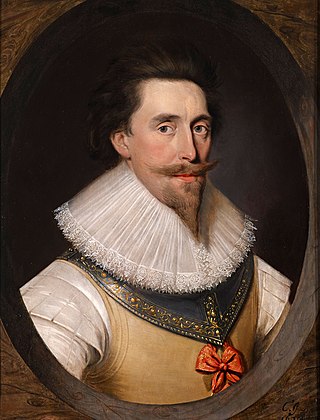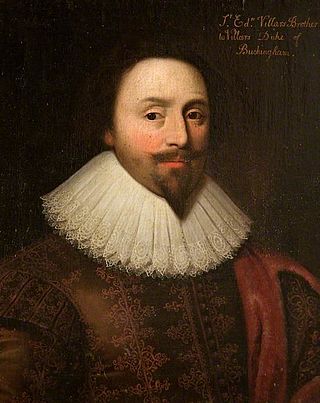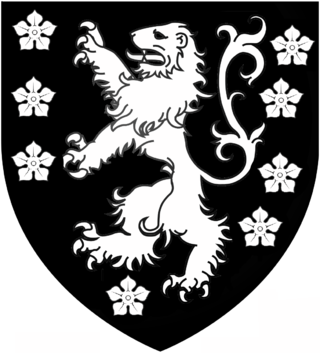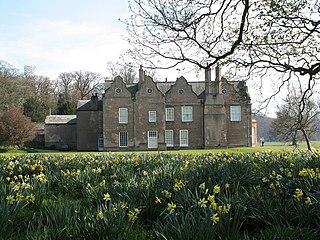Related Research Articles

Spencer Compton, 2nd Earl of Northampton, styled Lord Compton from 1618 to 1630, was an English soldier and politician who sat in the House of Commons from 1621 to 1622. He became a peer by writ of acceleration in 1626 and by inheritance in 1630. He fought in the Royalist army and was killed in action at the Battle of Hopton Heath.

Sir Edmund Verney was an English politician, soldier and favourite of King Charles I. At the outbreak of the English Civil War he supported the Royalist cause and was killed at the Battle of Edgehill.
Sir Frederick Fergus Graham, 5th Baronet KBE TD was a Conservative Party politician in the United Kingdom.

Francis Fane, 1st Earl of Westmorland, of Mereworth in Kent and of Apethorpe in Northamptonshire was an English landowner and politician who sat in the House of Commons between 1601 and 1624 and then was raised to the Peerage as Earl of Westmorland.
Sir John Hobart, 2nd Baronet was an English politician and baronet.

Thomas Dacre, 2nd Baron Dacre of Gilsland, KG was the son of Humphrey Dacre, 1st Baron Dacre of Gilsland and Mabel Parr, great-aunt of queen consort Catherine Parr, the sixth and final wife of King Henry VIII of England. His mother was the daughter of Sir Thomas Parr of Kendal by his wife, Alice Tunstall.
There have been eight baronetcies created for persons with the surname Graham, two in the Baronetage of Nova Scotia, two in the Baronetage of England, one in the Baronetage of Great Britain and three in the Baronetage of the United Kingdom.

John Savage, 2nd Earl Rivers was a wealthy English nobleman, politician and Royalist from Cheshire.

Sir Edward Villiers was an English nobleman from Leicestershire and member of the Villiers family, whose younger half-brother George Villiers, 1st Duke of Buckingham, was a favourite of both James VI and I and his son Charles. Through his influence, Sir Edward gained various positions, including Master of the Mint, Member of Parliament for Westminster and Lord President of Munster. He died in Ireland in September 1626.

Richard Graham, 1st Viscount Preston PC was an English diplomat and politician who sat in the House of Commons in two periods between 1675 and 1689. He became a Jacobite conspirator, but his reputation in the Jacobite community suffered when he gave evidence against his co-conspirators in exchange for a pardon.

Sir Gervase Clifton, 1st Baronet, K.B. was an English politician who sat in the House of Commons at various times between 1614 and 1666. He supported the Royalist cause in the English Civil War. He was educated at St John's College, Cambridge.
Sir Richard Courtenay Musgrave, 11th Baronet was an English Conservative Party politician who sat in the House of Commons from 1880 to 1881. He was educated at Eton College and was an officer in the 71st Highlanders. In 1872, he inherited the baronetcy on the death of his father. He was a JP and Deputy Lieutenant for Cumberland and became Lord Lieutenant of Westmorland in 1876.
Sir William Uvedale was an English politician who sat in the House of Commons at various times between 1614 and 1645. He supported the Royalist cause in the Civil War.

Sir William Whitmore was an English landowner and politician who sat in the House of Commons at various times between 1621 and 1626.
Sir Christopher Musgrave, 4th Baronet was an English landowner and politician who sat in the House of Commons from 1661 to 1704, and briefly became Father of the House in 1704 as the member with the longest unbroken service.

Norton Conyers House is a grade II* listed late medieval manor house with Stuart and Georgian additions sited in North Yorkshire, England, some 4 miles north of Ripon.
Villiers is an aristocratic family in the United Kingdom. Over time, various members of the Villiers family were made knights, baronets, and peers. Peerages held by the Villiers family include the dukedoms of Buckingham (1623–1687) and Cleveland (1670–1709), as well as the earldoms of Anglesey (1623–1661), Jersey, and Clarendon. Perhaps the most prominent members of the family were those who received the two dukedoms: George Villiers, 1st Duke of Buckingham (1592–1628) rose to fame and influence as favourite of King James I of England, while Barbara Villiers, Duchess of Cleveland (1640–1709) became a mistress of King Charles II of England, by whom she had five children.
Sir Edward Musgrave, 1st Baronet, was one of the Musgrave Baronets of Hayton Castle.
Sir James Graham, 1st Baronet was a British Tory politician.

Thomas Musgrave, Captain of Bewcastle was an English landowner and soldier involved in Scottish border politics. He was keeper of Bewcastle Castle for Elizabeth I.
References
- ↑ Samuel Rawson Gardiner, Prince Charles and the Spanish Marriage 1617-23, vol. 2 (London, 1869), p. 302.
- ↑ William Page, ed. (1914). "Parishes: Wath". Victoria County History. A History of the County of York North Riding: Volume 1. pp. 390–396. Retrieved 11 July 2017.
- 1 2 George Edward Cokayne Complete Baronetage Volume 2 1900